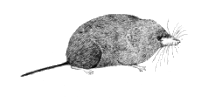All shrews are comparatively small, most no larger than a mouse. The largest species is the Asian house shrew (Suncus murinus) of tropical Asia, which is about 15 cm long and weighs around 100 grams; several are very small, notably the Etruscan shrew (Suncus etruscus), which at about 3.5 cm and 2 grams is the smallest living terrestrial mammal.
In general, shrews are terrestrial creatures that forage for seeds, insects, nuts, worms and a variety of other foods in leaf litter and dense vegetation, but some specialise in climbing trees, living underground, living under snow or even hunting in water. They have small eyes, and generally poor vision, but have excellent senses of hearing and smell.
They are very active animals, with voracious appetites. Shrews have an unusually high metabolic rate, above that expected in comparable small mammals. Shrews typically eat 80–90% of their own body weight in food daily.
They do not hibernate, but are capable of entering torpor. In winter, many species undergo morphological changes that drastically reduce their body weight. Shrews can lose between 30% and 50% of their body weight, shrinking the size of bones, skull and internal organs.
Whereas rodents have gnawing incisors that grow throughout life, the teeth of shrews wear down throughout life, a problem made more extreme because they lose their milk teeth before birth, and therefore have only one set of teeth throughout their lifetimes. Apart from the first pair of incisors, which are long and sharp, and the chewing molars at the back of the mouth, the teeth of shrews are small and peg-like, and may be reduced in number. The dental formula of shrews is3.1.1-3.31-2.0-1.1.3
Shrews are fiercely territorial, driving off rivals, and only coming together to mate. Many species dig burrows for caching food and hiding from predators, although this is not universal.
Female shrews can have up to 10 litters a year; in the tropics, they breed all year round; in temperate zones, they only stop breeding in the winter. Shrews have gestation periods of 17–32 days. The female often becomes pregnant within a day or so of giving birth, and lactates during her pregnancy, weaning one litter as the next is born.[3] Shrews live 12 to 30 months.
Shrews are unusual among mammals in a number of respects. Unlike most mammals, some species of shrew are venomous. Shrew venom is not conducted into the wound by fangs, but by grooves in the teeth. The venom contains various compounds, and the contents of the venom glands of the American short-tailed shrew are sufficient to kill 200 mice by intravenous injection. One chemical extracted from shrew venom may be potentially useful in the treatment of high blood pressure, while another compound may be useful in the treatment of some neuromuscular diseases and migraines. The saliva of the northern short-tailed shrew (Blarina brevicauda) contains the peptide soricidin, which has been studied for use in treating ovarian cancer.
Also, along with the bats and toothed whales, some species of shrews use echolocation. Unlike most other mammals, shrews lack zygomatic bones (also called the jugals), so have incomplete zygomatic arches.
